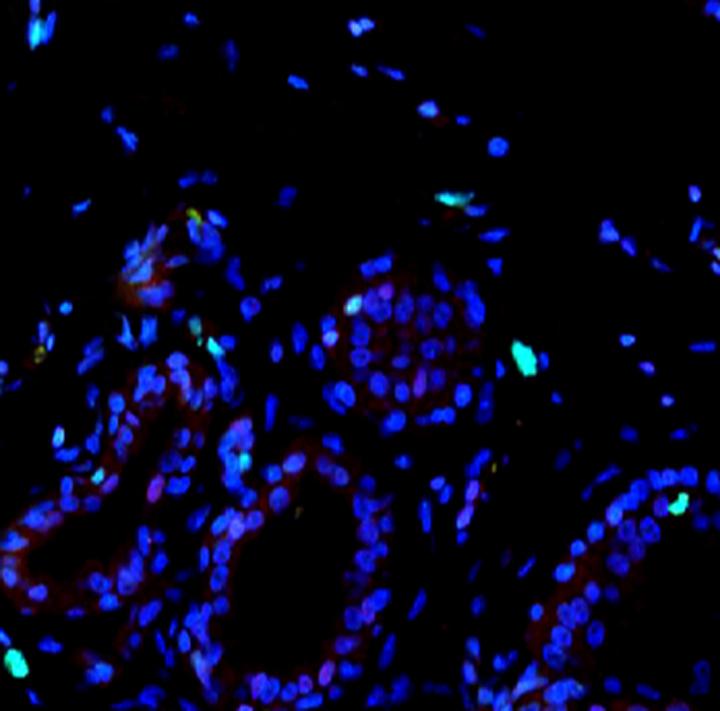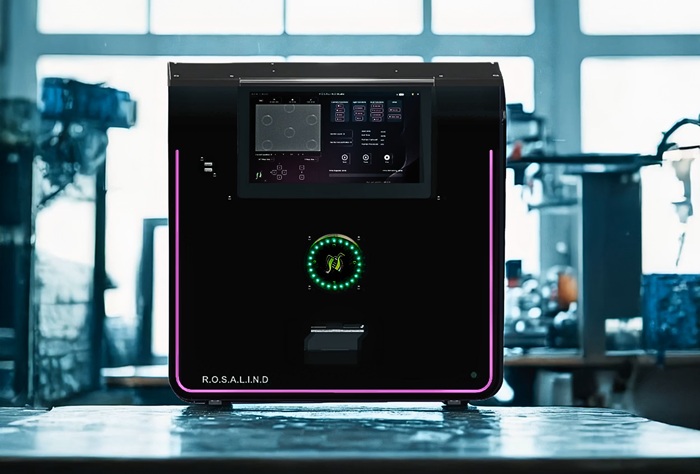Biomarker Predicts Breast Cancer Risk in Asymptomatic Women
|
By LabMedica International staff writers Posted on 18 Apr 2016 |

In healthy breast tissue, the percentage of cells expressing molecular marker Ki67 (green) and p27 (red) was low (Photo courtesy of Sung Jin Huh, Harvard Medical School).
A biomarker has been identified that may allow clinicians to predict the risk of an asymptomatic woman eventually developing breast cancer.
To identify this disease indicator, investigators at Harvard Medical School studied the association between breast cancer risk and the frequency of mammary epithelial cells expressing the proteins p27 (Cyclin-dependent kinase inhibitor 1B), estrogen receptor (ER), and Ki67 (Marker of proliferation Ki-67) in normal breast tissue from 302 women (69 breast cancer cases, 233 controls) who had been initially diagnosed with benign breast disease.
Immunofluorescence assays for p27, ER, and Ki67 were performed on tissue microarrays constructed from benign biopsies containing normal mammary epithelium and scored by computational image analysis.
Results revealed that the frequency of Ki67+ cells was positively associated with breast cancer risk among premenopausal women. Conversely, the frequency of ER+ or p27+ cells was inversely, but not significantly, associated with subsequent breast cancer risk. Notably, high Ki67+/low p27+ and high Ki67+/low ER+ cell frequencies were significantly associated with a five-fold higher risk of breast cancer compared with low Ki67+/low p27+ and low Ki67+/low ER+ cell frequencies, respectively, among premenopausal women.
This data suggests that the fraction of actively cycling cells in normal breast tissue may represent a marker for breast cancer risk assessment, which may therefore impact the frequency of screening procedures in at-risk women.
"Currently, we are not able to do a very good job at distinguishing women at high and low risk of breast cancer," said senior author Dr. Rulla Tamimi, associate professor of epidemiology at Harvard Medical School. "By identifying women at high risk of breast cancer, we can better develop individualized screening and also target risk reducing strategies."
The study was published in the April 1, 2016, issue of the journal Cancer Research.
Related Links:
Harvard Medical School
To identify this disease indicator, investigators at Harvard Medical School studied the association between breast cancer risk and the frequency of mammary epithelial cells expressing the proteins p27 (Cyclin-dependent kinase inhibitor 1B), estrogen receptor (ER), and Ki67 (Marker of proliferation Ki-67) in normal breast tissue from 302 women (69 breast cancer cases, 233 controls) who had been initially diagnosed with benign breast disease.
Immunofluorescence assays for p27, ER, and Ki67 were performed on tissue microarrays constructed from benign biopsies containing normal mammary epithelium and scored by computational image analysis.
Results revealed that the frequency of Ki67+ cells was positively associated with breast cancer risk among premenopausal women. Conversely, the frequency of ER+ or p27+ cells was inversely, but not significantly, associated with subsequent breast cancer risk. Notably, high Ki67+/low p27+ and high Ki67+/low ER+ cell frequencies were significantly associated with a five-fold higher risk of breast cancer compared with low Ki67+/low p27+ and low Ki67+/low ER+ cell frequencies, respectively, among premenopausal women.
This data suggests that the fraction of actively cycling cells in normal breast tissue may represent a marker for breast cancer risk assessment, which may therefore impact the frequency of screening procedures in at-risk women.
"Currently, we are not able to do a very good job at distinguishing women at high and low risk of breast cancer," said senior author Dr. Rulla Tamimi, associate professor of epidemiology at Harvard Medical School. "By identifying women at high risk of breast cancer, we can better develop individualized screening and also target risk reducing strategies."
The study was published in the April 1, 2016, issue of the journal Cancer Research.
Related Links:
Harvard Medical School
Latest Pathology News
- Rapid Low-Cost Tests Can Prevent Child Deaths from Contaminated Medicinal Syrups
- Tumor Signals in Saliva and Blood Enable Non-Invasive Monitoring of Head and Neck Cancer
- Common Health Issues Can Influence New Blood Tests for Alzheimer’s Disease
- Blood Test Formula Identifies Chronic Liver Disease Patients with Higher Cancer Risk
- Tunable Cell-Sorting Device Holds Potential for Multiple Biomedical Applications
- AI Tool Outperforms Doctors in Spotting Blood Cell Abnormalities
- AI Tool Rapidly Analyzes Complex Cancer Images for Personalized Treatment
- Diagnostic Technology Performs Rapid Biofluid Analysis Using Single Droplet
- Novel Technology Tracks Hidden Cancer Cells Faster
- AI Tool Improves Breast Cancer Detection
- AI Tool Predicts Treatment Success in Rectal Cancer Patients
- Blood Test and Sputum Analysis Predict Acute COPD Exacerbation
- AI Tool to Transform Skin Cancer Detection with Near-Perfect Accuracy
- Unique Immune Signatures Distinguish Rare Autoimmune Condition from Multiple Sclerosis
- Simple Optical Microscopy Method Reveals Hidden Structures in Remarkable Detail
- Hydrogel-Based Technology Isolates Extracellular Vesicles for Early Disease Diagnosis
Channels
Clinical Chemistry
view channel
POC Breath Diagnostic System to Detect Pneumonia-Causing Pathogens
Pseudomonas aeruginosa is a major cause of hospital-acquired and ventilator-associated pneumonia, particularly in lung transplant recipients and patients with structural lung disease. Its ability to form... Read more
Online Tool Detects Drug Exposure Directly from Patient Samples
Doctors often rely on patient interviews and medical records to determine what medications a person has taken, but this information is frequently incomplete. People may forget drugs they used, take over-the-counter... Read moreMolecular Diagnostics
view channel
DNA Detection Platform Enables Real-Time Molecular Detection
A next-gen DNA detection platform enables real-time molecular detection by detecting nucleic acids directly without enzymes or thermocyclers, thereby slashing costs, reducing complexity, and boosting reliability... Read more
STI Molecular Test Delivers Rapid POC Results for Treatment Guidance
An affordable, rapid molecular diagnostic for sexually transmitted infections (STIs) has the potential to be globally relevant, particularly in resource-limited settings where rapid, point-of-care results... Read moreHematology
view channel
MRD Tests Could Predict Survival in Leukemia Patients
Acute myeloid leukemia is an aggressive blood cancer that disrupts normal blood cell production and often relapses even after intensive treatment. Clinicians currently lack early, reliable markers to predict... Read more
Platelet Activity Blood Test in Middle Age Could Identify Early Alzheimer’s Risk
Early detection of Alzheimer’s disease remains one of the biggest unmet needs in neurology, particularly because the biological changes underlying the disorder begin decades before memory symptoms appear.... Read more
Microvesicles Measurement Could Detect Vascular Injury in Sickle Cell Disease Patients
Assessing disease severity in sickle cell disease (SCD) remains challenging, especially when trying to predict hemolysis, vascular injury, and risk of complications such as vaso-occlusive crises.... Read more
ADLM’s New Coagulation Testing Guidance to Improve Care for Patients on Blood Thinners
Direct oral anticoagulants (DOACs) are one of the most common types of blood thinners. Patients take them to prevent a host of complications that could arise from blood clotting, including stroke, deep... Read moreImmunology
view channel
Blood Test Could Identify Colon Cancer Patients to Benefit from NSAIDs
Colon cancer remains a major cause of cancer-related illness, with many patients facing relapse even after surgery and chemotherapy. Up to 40% of people with stage III disease experience recurrence, highlighting... Read moreBlood Test Could Detect Adverse Immunotherapy Effects
Immune checkpoint inhibitors have transformed cancer treatment, but they can also trigger serious immune-related adverse events that damage healthy organs and may become life-threatening if not detected early.... Read moreMicrobiology
view channel
Breakthroughs in Microbial Analysis to Enhance Disease Prediction
Microorganisms shape human health, ecosystems, and the planet’s climate, yet identifying them and understanding how they are related remains a major scientific challenge. Even with modern DNA sequencing,... Read more
Blood-Based Diagnostic Method Could Identify Pediatric LRTIs
Lower-respiratory tract infections (LRTIs) are a leading cause of illness and death worldwide, and pneumonia is the leading infectious cause of death in children under five, claiming the lives of over... Read moreTechnology
view channel
Machine Learning Models Diagnose ALS Earlier Through Blood Biomarkers
Amyotrophic lateral sclerosis (ALS) is a rapidly progressive neurodegenerative disease that is notoriously difficult to diagnose in its early stages. Early symptoms often overlap with other neurological... Read more
Artificial Intelligence Model Could Accelerate Rare Disease Diagnosis
Identifying which genetic variants actually cause disease remains one of the biggest challenges in genomic medicine. Each person carries tens of thousands of DNA changes, yet only a few meaningfully alter... Read moreIndustry
view channel
BD and Penn Institute Collaborate to Advance Immunotherapy through Flow Cytometry
BD (Becton, Dickinson and Company, Franklin Lakes, NJ, USA) has entered into a strategic collaboration with the Institute for Immunology and Immune Health (I3H, Philadelphia, PA, USA) at the University... Read more




 assay.jpg)

















